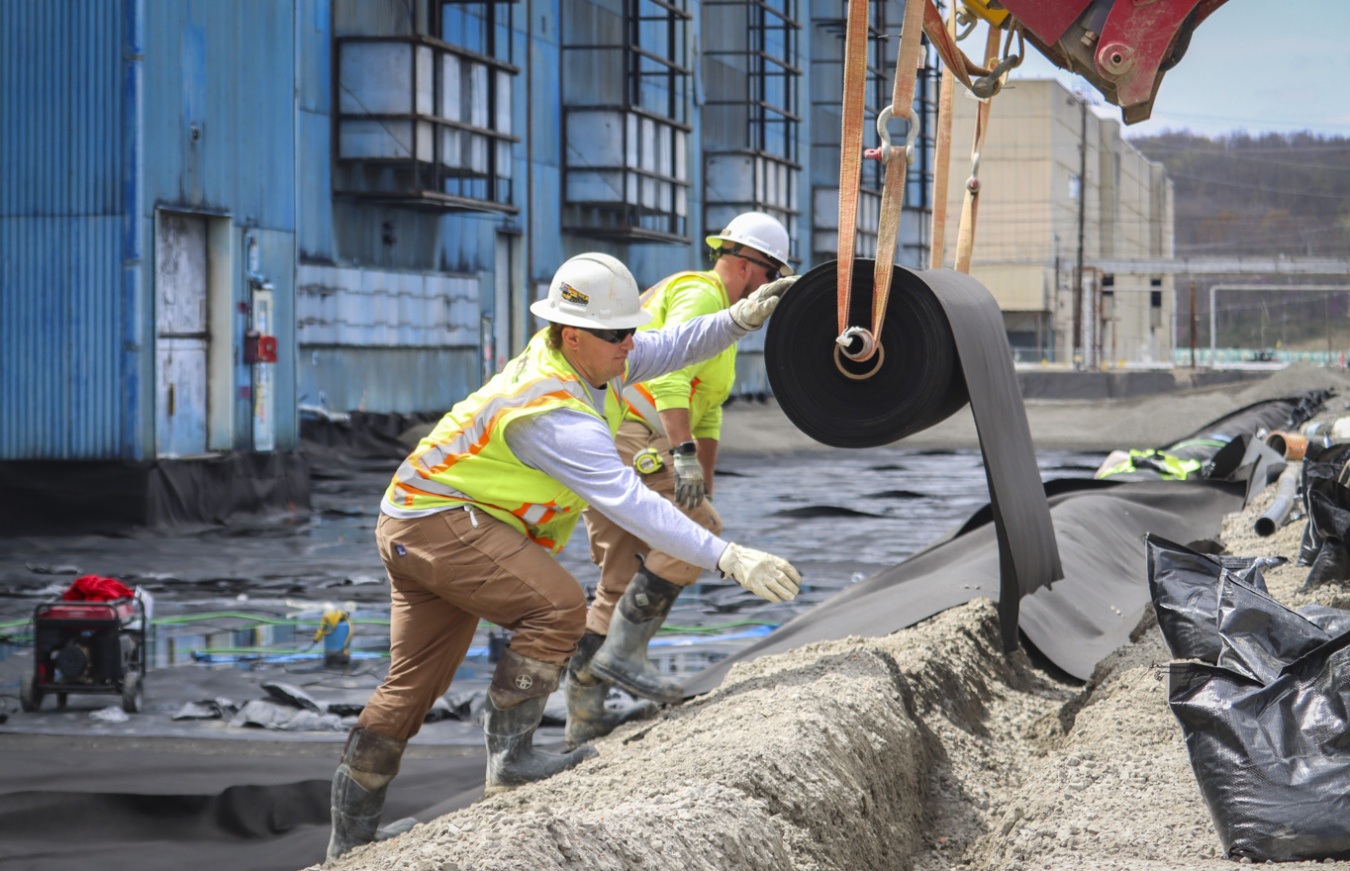With crews in the early stages of demolishing X-333, the second of the Portsmouth Site’s three former uranium process buildings, U.S. Department of Energy Office of Environmental Management leaders at the site are emphasizing the number one priority: safety of the workforce and community. November 25, 2025
Office of Environmental Management
November 25, 2025Laborers Tyler Roach, left, and Taylor Brown assist with the installation of liner to construct a water detention berm around the Portsmouth Site X-333 Process Building.
Portsmouth Site priority reflects DOE core value of safe work performance
PIKETON, Ohio — With crews in the early stages of demolishing X-333, the second of the Portsmouth Site’s three former uranium process buildings, U.S. Department of Energy (DOE) Office of Environmental Management (EM) leaders at the site are emphasizing the number one priority: safety of the workforce and community.
From incorporating lessons learned from previous work to ensuring dust suppression, water collection systems and project-specific air monitors are working as designed, all measures complement each other to complete the project safely.
“When we began the process of demolishing the first process building on the site, we had numerous discussions with other sites and incorporated lessons learned into the demolition plan to ensure we were using the gold standard in safety practices,” Portsmouth Site Lead Jeremy Davis said. “This was the starting point. From there, everything we did built on a solid plan to ensure safety was at the top of the list.”
Demolition Specialist Jeff Howard sprays a blue fixative on the Portsmouth Site X-333 Process Building to maintain dust control on the transite panels during removal.
EM is in lockstep with a core DOE value of safe work performance, fostering a safety conscious work environment where employees understand their roles and responsibilities for safety and health, and learn from experience.
At Portsmouth, the first process building to be demolished was the 62-foot tall, 29-acre X-326 Process Building in 2022. Extensive safety practices and environmental monitoring conducted before and during that demolition resulted in zero recordable injuries for project workers and zero exceedances in air monitoring.
On Sept. 25, structural demolition began on the largest of the three process buildings, the X-333 Process Building.
Before demolition could begin, crews worked inside the building to complete deactivation of the 33-acre facility, which has two stories and 66 acres of floor space under roof. Deactivation includes characterizing the building and equipment from a radiological standpoint; disconnecting process equipment; preparing waste for onsite or offsite disposal; removing asbestos and other hazardous waste; and isolating and disconnecting utilities.
Crews also implemented safety measures, including installing fencing; removing above-grade structures and pads around the building; installing a perimeter liner, berm and water collection and treatment system; installing air monitors around the building; and applying fixative to maintain dust suppression.
“Before the first bolt was cut to begin demolition, we put several measures in place to protect not only our workers, but also our community,” Federal Project Director Christy Brown said. “We all live here, our families are here, so safety is personal to us.”
Air monitors are strategically placed around the X-333 Process Building demolition project to provide real-time data to alert project leadership if any issues arise. The final application of blue fixative to maintain dust control on the transite panels is visible in the background.
The liner around the building catches the water used to spray the building during demolition, which is then run through a treatment-and-filtration system and tested. Air monitors provide real-time data on the project to alert project leadership if any issues arise. The air monitors, placed strategically around the project, are in addition to permanent air monitoring stations around the site. The permanent air monitoring stations located both on the Portsmouth Site and in the surrounding area are positioned next to co-located monitors operated by the Ohio Environmental Protection Agency and the Department of Health.
“From Perimeter Road, you can see that we have sprayed the building a bluish color,” Brown said. “That is a special fixative. It is used to keep particles from the building drifting into the air.”
Using the fixative, along with spraying the building with water, prevented air emissions during the demolition of the first process building and the team is confident that the approach will also be effective for demolition of X-333.
“Our workers also are very vigilant in watching for anything that might even look like it is unsafe,” Southern Ohio Cleanup Company (SOCCo) Portsmouth Site Project Director Greg Wilkett said. “If something is seen that could be a potential hazard, work is stopped, and the concern is addressed. That is just the culture we have here onsite.”
SOCCo is the Portsmouth Site cleanup contractor performing demolition of X-333 and the upcoming X-330 Process Building. The Portsmouth Paducah Project Office conducts cleanup activities at the Portsmouth Site in accordance with a consent decree with the state of Ohio and director’s final findings and orders with the Ohio Environmental Protection Agency.
-Contributor: Shawn Jordan
To receive the latest news and updates about the Office of Environmental Management, submit your e-mail address.



